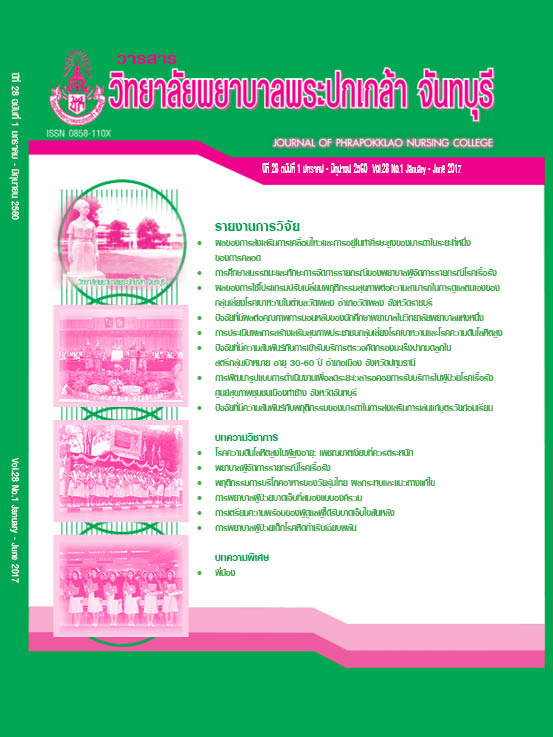Factors Associated with Maternal Behavior in Promoting Play for Their Preschool Children
Keywords:
Maternal behavior, Promoting play, Child temperament, Home environmentAbstract
This descriptive correlational research aimed to examine the relationship between child temperament, home environments, and maternal behavior in promoting play for their preschool children. The samples consisted of 76 mothers of preschool children receiving service at child care center, Kabin Buri District, Prachin Buri Province. The research instruments composed of the demographic questionnaire, the preschool children temperament questionnaire with the reliability of .83, the home environment questionnaire with the reliability of .78, and the maternal behavior in promoting play for their preschool children questionnaire with the reliability of .93. Data were collected from February to March, 2015. Statistics used for data analysis included frequency, percentage, mean, standard deviation, and Pearson’s product moment correlation.
The results revealed that child temperament and home environments were positively statistically significant correlation with maternal behavior in promoting play for their preschool children (r = .438, p < .01 and r = .275, p < .05, respectively).
This study suggested that pediatric nurses should encourage mothers to promote child’s play, especially the mothers who have children with difficult temperament and providing appropriate child’s home environment.
References
คำพวง ห่อทอง. (2548). การศึกษาเปรียบเทียบพฤติกรรมส่งเสริมการเล่นของบิดามารดาและพฤติกรรมการปรับตัวของเด็กปฐมวัย ในเขตกรุงเทพมหานครกับจังหวัดสุรินทร์ (สารนิพนธ์ปริญญามหาบัณฑิต). กรุงเทพฯ: มหาวิทยาลัยศรีนครินทรวิโรฒ.
จิตตินันท์ เดชะคุปต์. (2547). สภาพแวดล้อมของครอบครัว. ใน ภัทรา สง่า. (บ.ก.). สถานภาพครอบครัวศึกษา. กรุงเทพฯ: สำนักงานกองทุนสนับสนุนการวิจัย.
ไฉไล ช่างดำ. (2550). ความรู้ เจตคติ และการปฏิบัติตนของบิดามารดาในการส่งเสริมพัฒนาการเด็กอายุ 1-3 ปี ในตำบลธาตุ อำเภอวารินชำราบ จังหวัดอุบลราชธานี (วิทยานิพนธ์ปริญญามหาบัณฑิต). นนทบุรี: มหาวิทยาลัยสุโขทัยธรรมาธิราช.
ชาญวิทย์ พรนภดล. (2555). บทวิเคราะห์งานวิจัยสถานการณ์เด็กติดเกม. กรุงเทพฯ: มหาวิทยาลัยมหิดล.
นฤภรณ์ ถิรภัทรพันธ์. (2545). ปัจจัยทางจิตวิทยาที่เป็นตัวทำนายพฤติกรรมของมารดาในการส่งเสริมพัฒนาการทางด้านอารมณ์ของเด็กก่อนวัยเรียนในเขตอำเภอบ้านโป่ง จังหวัดราชบุรี (วิทยานิพนธ์ปริญญามหาบัณฑิต). กรุงเทพฯ: มหาวิทยาลัยศิลปากร.
นาตยา แสงใส, นุจรี ไชยมงคล, และมณีรัตน์ ภาคธูป. (2554). ปัจจัยทำนายพฤติกรรมการปรับตัวของเด็กวัยก่อนเรียนที่รับบริการในศูนย์เลี้ยงเด็กกลางวัน. วารสารคณะพยาบาลศาสตร์ มหาวิทยาลัยบูรพา, 19(2), 97-109.
บุญใจ ศรีสถิตย์นรากูร. (2553). ระเบียบวิธีการวิจัยทางพยาบาลศาสตร์ (พิมพ์ครั้งที่ 5). กรุงเทพฯ: ยูแอนด์ไอ อินเตอร์มีเดีย.
รัมภ์รดา อินทโฉม, และมัทนา อังศุไพศาล. (2555). ความรู้และความบ่อยของพฤติกรรมของผู้ดูแลหลักในชุมชนคลองหนองเหล็ก เพื่อการส่งเสริมพัฒนาการของเด็กปฐมวัย. วารสารกายภาพบำบัด, 33(3), 114-125.
สมภาร พรมทา. (2553). รากเหง้าเราคือทุกข์ (พิมพ์ครั้งที่ 2). กรุงเทพฯ: วารสารปัญญา.
สาวิตรี วงศ์อินจันทร์, ยุนี พงศ์จตุรวิทย์, และนุจรี ไชยมงคล. (2558). ปัจจัยทำนายพฤติกรรมการเล่นของเด็กวัยก่อนเรียนที่เข้ารับบริการในศูนย์พัฒนาเด็กเล็ก. วารสารสาธารณสุข มหาวิทยาลัยบูรพา, 10(1), 65-76.
สุรพล สีห์สุรงค์. (2551). พฤติกรรมการเล่นเกมส์คอมพิวเตอร์ของเด็กนักเรียนในเขตอำเภอเมืองเชียงใหม่ จังหวัดเชียงใหม่ (วิทยานิพนธ์ปริญญามหาบัณฑิต). มหาวิทยาลัยเชียงใหม่.
อมลวรรณ วีระธรรมโม. (2549). การเล่น: กิจกรรมเพื่อการส่งเสริมพัฒนาการของเด็กปฐมวัย. วารสารสำนักหอสมุด มหาวิทยาลัยทักษิณ, 5(1), 77-87.
อัจฉรา เปรื่องเวทย์. (2552). การจัดการเล่นเพื่อส่งเสริมพัฒนาการเด็กวัย 0-5 ปี. สืบค้น วันที่ 22 มกราคม 2557, จาก http://www.ns.mahidol.ac.th/english/th/departments/PN/TH/article/
Bronfenbrenner, U. (1994). Ecological models of human development. In International Encyclopedia of Education Vol. 3 (2nd ed.). pp. 37-43. Oxford: Elsevier.
Herwig, J. E., & Tejagupta, C. (1992). An investigation of mother-father-child home play, parental involvement and home environment of American preschoolers. In Proceedings of the 30th Kasetsart University Annual Conference: Economics and Business Administration, Social Sciences, Education, Humanities, Environment, Home Economics, Agro-Industry, Science, Engineering. pp. 353-360. January 29 - February 1, 1992. Ministry of Science and Technology.
Laukkanen, J., Ojansuu, U., Tolvanen, A., Alatupa, S., & Aunola, K. (2014). Child’s difficult temperament and mother’ parenting styles. Journal of Child and Family Studies, 23(2), 312-323.
McDevitt, S. C., & Carey, W. B. (1978). The measurement of temperament in 3-7 year old children. The Journal of Child Psychology and Psychiatry, 19(3), 245-253.
O’Dwyer, M. V., Fairclough, S. J., Knowles, Z., & Stratton, G. (2012). Effect of a family focused active play intervention on sedentary time and physical activity in preschool children. International Journal of Behavioral Nutrition and Physical Activity, 9, 117.
Tamis-LeMonda, C. S., Shannon, J. D., Cabrera, N. J., & Lamb, M. E. (2004). Fathers and mothers at play with their 2- and 3-year-olds: Contributions to language and cognitive development. Child Development, 75(6), 1806-1820.
Thomas, A., & Chess, S. (1977). Temperament and development. New York: Brunner/Mazel Publishers.
Downloads
Published
How to Cite
Issue
Section
License
Copyright (c) 2017 Journal of Phrapokklao Nursing College

This work is licensed under a Creative Commons Attribution-NonCommercial-NoDerivatives 4.0 International License.
เนื้อความ ข้อมูล และรายการอ้างอิงที่ผู้เขียนใช้ในการเขียนบทความเพื่อลงตีพิมพ์ในวารสารวิทยาลัยพยาบาลพระปกเกล้า จันทบุรี ถือเป็นความคิดเห็นและความรับผิดชอบของผู้เขียน คณะผู้จัดทำวารสารไม่จำเป็นต้องเห็นพ้องด้วยหรือร่วมรับผิดชอบ
บทความที่ได้รับการลงตีพิมพ์ในวารสารวิทยาลัยพยาบาลพระปกเกล้า จันทบุรี ถือเป็นลิขสิทธิ์ของวารสารวิทยาลัยพยาบาลพระปกเกล้า จันทบุรี หากหน่วยงานหรือบุคคลใดต้องการนำส่วนหนึ่งหรือทั้งหมดของบทความไปเผยแพร่ต่อเพื่อวัตถุประสงค์ใด ๆ จะต้องได้รับอนุญาตจากบรรณาธิการวารสารก่อน



